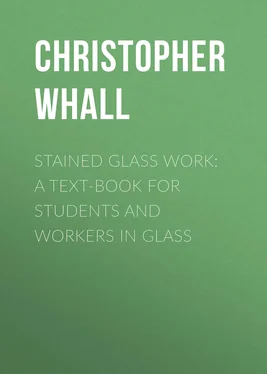Christopher Whall - Stained Glass Work - A text-book for students and workers in glass
Здесь есть возможность читать онлайн «Christopher Whall - Stained Glass Work - A text-book for students and workers in glass» — ознакомительный отрывок электронной книги совершенно бесплатно, а после прочтения отрывка купить полную версию. В некоторых случаях можно слушать аудио, скачать через торрент в формате fb2 и присутствует краткое содержание. Жанр: foreign_antique, foreign_home, visual_arts, на английском языке. Описание произведения, (предисловие) а так же отзывы посетителей доступны на портале библиотеки ЛибКат.
- Название:Stained Glass Work: A text-book for students and workers in glass
- Автор:
- Жанр:
- Год:неизвестен
- ISBN:нет данных
- Рейтинг книги:3 / 5. Голосов: 1
-
Избранное:Добавить в избранное
- Отзывы:
-
Ваша оценка:
- 60
- 1
- 2
- 3
- 4
- 5
Stained Glass Work: A text-book for students and workers in glass: краткое содержание, описание и аннотация
Предлагаем к чтению аннотацию, описание, краткое содержание или предисловие (зависит от того, что написал сам автор книги «Stained Glass Work: A text-book for students and workers in glass»). Если вы не нашли необходимую информацию о книге — напишите в комментариях, мы постараемся отыскать её.
Stained Glass Work: A text-book for students and workers in glass — читать онлайн ознакомительный отрывок
Ниже представлен текст книги, разбитый по страницам. Система сохранения места последней прочитанной страницы, позволяет с удобством читать онлайн бесплатно книгу «Stained Glass Work: A text-book for students and workers in glass», без необходимости каждый раз заново искать на чём Вы остановились. Поставьте закладку, и сможете в любой момент перейти на страницу, на которой закончили чтение.
Интервал:
Закладка:
Take a bit of glass, say 3 inches by 2, and make the very smallest dint you can in it, in the middle of the narrowest dimension. You cannot make one so small that the glass will hold together if you try to break it across. It will break across in a straight line, springing from each end of the tiny cut. The cut may be only 1/8 of an inch long; less—it may be only 1/16, 1/32—as small as you will, the glass will break across just the same.
Why?
Because the cut has started it splitting at each end; and the material being the same all through, the split will go straight on in the direction in which it has started; there is nothing to turn it aside.
So also the pressure of the wheel starts a continuous split, or series of splits, downwards , into the thickness of the glass. No matter how small a distance these go in, the glass will come asunder directly pressure is applied.
Now, if you press too hard in cutting, another thing takes place.
Imagine a quantity of roofing-slates piled flat one on top of another, all the piles being of equal height and arranged in two rows, side by side, so close that the edges of the slates in one row touch the edges of those in the other row, along a central line.
Wheel a wheelbarrow along that line over the edges of both.
What would happen?
The top layer of slates would all come cocking their outer edges up as the barrow passed over their inner ones, would they not?
Now, just so, if you press hard on your glass-cutting wheel, it will press down the edges of the groove, and though there are no layers already made in the glass, the pressure will split off a thin layer from the top surface of the glass on each side in flakes as it goes along (Plate X. Конец ознакомительного фрагмента. Текст предоставлен ООО «ЛитРес». Прочитайте эту книгу целиком, купив полную легальную версию на ЛитРес. Безопасно оплатить книгу можно банковской картой Visa, MasterCard, Maestro, со счета мобильного телефона, с платежного терминала, в салоне МТС или Связной, через PayPal, WebMoney, Яндекс.Деньги, QIWI Кошелек, бонусными картами или другим удобным Вам способом.
, d, e).
This is what gives the noise of the cut, c-r-r-r-r-r-; and as the thing is no use the noise is no use; like a good many other things in life, the less noise the better work, much cry generally meaning little wool, as the man found out who shaved the pig.
But the wheel or the diamond is not quite the same as the wheel of the wheelbarrow, for it has a wedge-shaped edge. Imagine a barrow with such a wheel; what then would happen to your slates? besides being cocked up by the wheel, they would also be pushed out , surely?
This happens in glass. You must not imagine that glass is a rigid thing; it is very elastic, and the wedge-like pressure of the wheel pushes it out just as the keel of a boat pushes the water aside in ripples (Plate X. Конец ознакомительного фрагмента. Текст предоставлен ООО «ЛитРес». Прочитайте эту книгу целиком, купив полную легальную версию на ЛитРес. Безопасно оплатить книгу можно банковской картой Visa, MasterCard, Maestro, со счета мобильного телефона, с платежного терминала, в салоне МТС или Связной, через PayPal, WebMoney, Яндекс.Деньги, QIWI Кошелек, бонусными картами или другим удобным Вам способом.
, d, e).
All these observations seem to me to bear out the theory of the inventor, and perhaps to some extent to explain it. I am much tempted to carry them further, and ask the questions, why a penknife as well as a wheel will not make a cut in glass, but will make a perfectly definite scratch on it if the glass is placed under water? and why this line so made will yet not serve for separating the glass? and why a piece of glass can be cut in two (roughly, to be sure, but still cut in two) with a pair of scissors under water, a thing otherwise quite impossible?
But I do not think that the knowledge of these questions will help the reader to do better stained-glass windows, and therefore I will not pursue them.
(2) The question of sharpening the tool is soon disposed of.
If the tool is to be sharpened, the jaws must be ground down, whether the maker grinds them down originally or whether we do it. Is sharpening worth while, since the tool only costs a few pence?
Well, it's a question each must decide for himself; but I will just answer two small difficulties which affect the matter.
If grinding the jaws loosens the pivot, it can be hammered tight again with a punch. If sharpening wears out the oil-stone (as it undoubtedly does, and oil-stones are expensive things), a piece of fine polished Westmoreland slate will do as well, and there is no need to be chary of it. Even a piece of ground-glass with oil will do.
(3) But now as to the handle. I am first to explain the amusing "mystery" why the old pattern shown in fig. 1 still sells.
It is because the British working-man is convinced that the wheels in this handle are better quality than any others .
Is he right, or is it only an instance of his love for and faith in the thing he has got used to?
Or can it be that all workmen do not know of the existence of the other types of handle? In case this is so, I figure some (fig. 17). Or is it that the wheel for some reason runs less truly in the malleable iron than in the cast iron?

Fig. 17.
Certain it is that the whole trade here prefers these wheels, and I am bound to say that as far as my experience goes they seem to me to work better than those in other handles.
But as to all the handles themselves, I must now voice our general complaint.
(1) They are too light.
For tapping our heavy antique and slab-glasses we wish we had a heavier tool.
(2) They are too thin in the handle for comfort, at least it seems so to me.
(3) The three gashes cut out of the head of the tool decrease the weight, and if these were omitted the tool would gain. Their only use that I can conceive of is that of a very poor substitute for pliers as a "groseing" tool, if one has forgotten one's pliers. But (as Serjeant Buzfuz might say) "who does forget his pliers?"
The whole question of the handle is complicated by the fact that some cutters rest the tool on the forefinger and some on the middle finger in tapping, and that a handle the sections of which are calculated for the one will not do equally well for the other.
But the whole thing resolves itself into this, that if we could get a tool, the handle of which corresponded in all its curves, dimensions, and sections with the old-established diamond, I think we should all be glad; and if the head, wheel, and pivot were all made of the quality and material of which fig. 1 is now made, but with the handle as I describe, many of us, I think, would be still more glad; and if these remarks lead in any degree to such results, they at least of all the book will have been worth the writing, and will probably be its best claim to a white stone in Israel, as removing one more solecism from "this so-called twentieth century."
Читать дальшеИнтервал:
Закладка:
Похожие книги на «Stained Glass Work: A text-book for students and workers in glass»
Представляем Вашему вниманию похожие книги на «Stained Glass Work: A text-book for students and workers in glass» списком для выбора. Мы отобрали схожую по названию и смыслу литературу в надежде предоставить читателям больше вариантов отыскать новые, интересные, ещё непрочитанные произведения.
Обсуждение, отзывы о книге «Stained Glass Work: A text-book for students and workers in glass» и просто собственные мнения читателей. Оставьте ваши комментарии, напишите, что Вы думаете о произведении, его смысле или главных героях. Укажите что конкретно понравилось, а что нет, и почему Вы так считаете.












